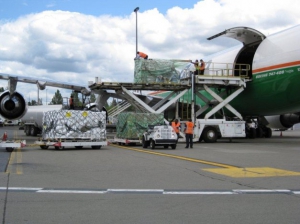The Port of Seattle, a gateway to markets in Asia, is gaining air cargo capacity but some cherry growers remain dissatisfied with fees and facilities at Seattle-Tacoma International Airport.
Port Commissioners recently completed a tour of central and eastern Washington, briefing growers on trends affecting cargo movement in and out of Puget Sound via air or sea shippers. The commissioners warned of increasing competition from Canadian ports, inadequate funding for road improvements needed to move cargo, and congestion around terminals in Seattle’s central waterfront.
Tom Green, the port’s senior manager Air Cargo Development, said airlift capacity has grown at Sea-Tac as a result of increased flights by all-cargo freighter jets and by new or increased flights by passenger jets carrying cargo in their bellies. Since 2007, the port has added passenger flights to Beijing and Shanghai (starting in June). Delta Airlines has increased service out of Sea-Tac to Japan. And Sea-Tac gained a new carrier, All Nippon Airways (ANA).
A freighter can carry 100 tons of cargo. Freighter service from Sea-Tac by two Asian carriers, China Airlines and Korean Air, nearly triples during cherry season. According to the port, China Air goes from a normal schedule of 12 flights per month to 40 flights per month in July, the peak of the cherry season. Korean Air goes from 24 flights a month to 50 flights a month.
According to the port, counting all carriers 32.2 million pounds of cherries left Sea-Tac, up from 25.2 million pounds the year before.
Port officials heard from growers about dissatisfaction with Sea-Tac’s cargo capacity, fees and inadequate chill facilities.
Rather than ship their cherries through Sea-Tac, some Washington growers pay the added expense of trucking cherries to San Francisco or Los Angeles, where cargo capacity to Asia is greater. At a meeting in Wenatchee, Washington, one grower explained why he must use a California airport, according to the Wenatchee World newspaper. “We’re getting better shipping rates and better lift (cargo plane capacity) at California ports,” said Dave Martin, export sales manager for Wenatchee-based Stemilt Growers, one of the nation’s largest fruit companies. “At SeaTac, it’s tough to get enough capacity when we really need it.”
Sea-Tac officials say pressure from growers on shipping companies will contribute to increasing cargo capacity at the airport. More shipping through Sea-Tac will also generate greater competition on rates charged by freight forwarders, they say.
“Our capacity is growing and we encourage growers to push freight forwarders to insist on shipping through Sea-Tac, as that will increase the carriers flights and/or increase competition with another carrier willing to send flights here,” airport spokesman Perry Cooper said in a follow up interview.
Sea-Tac is the third-largest airport for international cargo on the West Coast. Learn about Sea-Tac’s cargo facilities.


Where is the study on why there is no development at the Moses lake airport to support chill facilities and support for cargo flights of Central WA fruit direct from Central WA versus all of the transport and port fees involved with the Port of Seattle?
Bill, This is an excellent question. Perhaps the Port of Moses Lake would have an answer for you. Thanks.